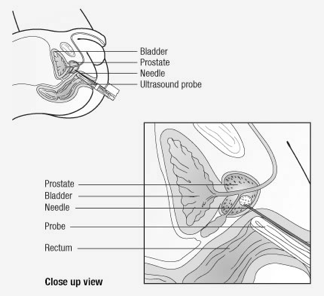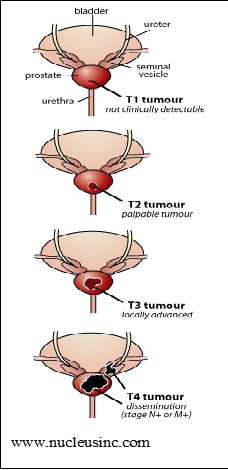The actual diagnosis of prostate cancer is made by way of biopsy, where tissue samples are taken from the prostate. There are three different biopsy procedures:
- Transrectal Ultrasound guided prostate biopsy (TRUS)
- Transperineal Ultrasound guided prostate biopsy (TPUS)
- MRI Guided biopsy

Staging and grading
If prostate cancer is present then a stage and grade will be assigned to the prostate cancer.
Staging
Staging is the extent of the cancer, assessed by both physical examination and radiological scans such as a CT scan, bone scan, chest Xray and occasionally an MRI scan.
The TNM system is used for staging (size of tumour, presence of lymph nodes, and metastases (or how far the cancer has spread).
- T = the tumour
- N = the lymph node or gland involvement
- M = the spread of cancer (metastases)
T1: The tumour or cancer cannot be felt by the doctor during examination.
T2: The cancer can be felt but it has not spread outside of the prostate.
T3: The cancer has spread outside of the prostate into nearby tissues.
T4: The cancer has spread into nearby organs such as the bladder.

Grading
Grading is used by pathologists to describe the patterns of cancerous cells that are seen under the microscope. These patterns of cell formation then relate to the aggressiveness of cancer, its clinical characteristics and its potential future behaviour.
Based on the most common pattern of cells, the pathologist assigns a number from 1-5. 1 is the least aggressive and 5 is the most aggressive. Based on the second most common pattern of cells the pathologist assigns a second number from 1-5. The sum of these 2 numbers is known as the Gleason score, e.g. 3+4=7. Most prostate cancers have a Gleason score of between 6 and 10. Gleason score 6 is the least aggressive and Gleason score 10 is the most aggressive.



